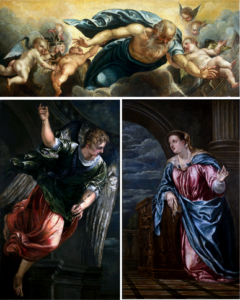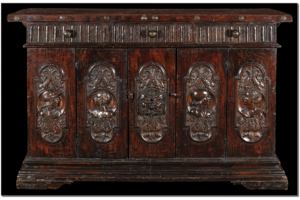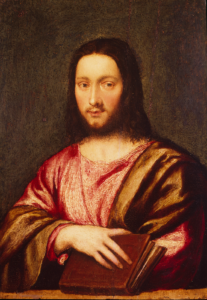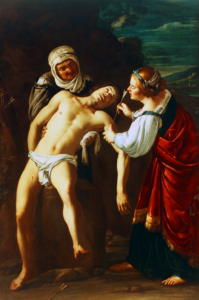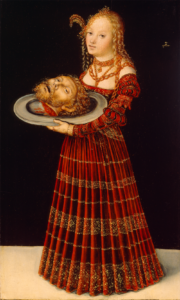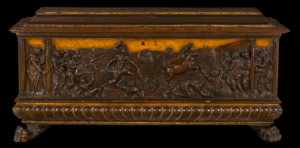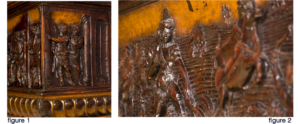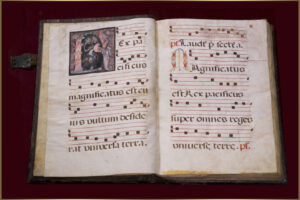This vibrant painting depicting Abraham and his family’s departure for Canaan features many of the details that the Bassano family were skilled in painting.
Tag Archives: 16th century
Scenes from The Annunciation: God the Father in a Glory of Angels, St. Gabriel the Archangel and The Virgin Annunciate
Oil on canvas
Francesco Montemezzano
Venetian, c.1540-after 1602
In museum collections, including the Museum & Gallery, there are paintings that were once part of a larger narrative, but now stand as individual works of art. These pieces, usually parts of large altarpieces, have been reduced in size for various reasons such as damage to the whole, for profit, or to fit a new arrangement. Very few that have been broken up have managed to stay together. Francesco Montemezzano’s The Annunciation is one of those lucky few.
At first glance in the galleries, you may notice a similar velvety color palette and free brushwork but may not realize they are one of a whole. If not for the close arrangement in display, one may not be able to see the full image. Originally in a horizontal format, the painting was altered sometime in the seventeenth century to fit a vertical, architectural enframement. Despite this physical cropping, we can still see the theme of the annunciation.
The annunciation is a common subject portrayed in Christian art. The moment is recorded in Luke 1:26-38 where Gabriel informs Mary that she will fulfill the prophecy of Isaiah 7:14 promising “a virgin shall conceive and bear a Son, and shall call His name Immanuel.” This theme became very popular in fifteenth-century altarpieces and were reinterpreted by artists throughout history such as Fra Angelico, Leonardo da Vinci, Botticelli, Caravaggio, Peter Paul Rubens, and John William Waterhouse. Each artist put their own spin on the theme, reflecting the stylistic ethos of the time and the artists’ own taste, but there are common elements.
Mary, Gabriel, and a dove are the main figures. Sometimes they are outside in an hortus conclusus or “enclosed garden,” and other times they are cloistered inside, symbolizing Mary’s chastity. Lilies are usually present, carried by Gabriel or somewhere in the composition, further emphasizing Mary’s purity as a virgin. Mary is commonly shown in prayer with a prayer book or missal kneeling at a prie-dieu. A dove or beam of light usually represents God’s blessing on Mary as His chosen handmaiden or the symbol of immaculate conception.
With this brief background, Montemezzano’s Annunciation stands out. We can see architectural elements throughout the three paintings and a possible garden behind Mary. Was this Montemezzano’s nod to the hortus conclusus? And where is the dove or beam of light that is often shown? Because of its fragmented state, we may never know exactly what the artist designed. However, Montemezzano did include one unique figure in this Annunciation—God the Father. Very few depictions of the annunciation include a physical God the Father, most only show his messenger Gabriel and the dove.
There are actually two other annunciation scenes in M&G’s collection that show God the Father in physical form (one found in galleries 4 and 10). Here, in Montemezzano’s work, God the Father is shown breaking through clouds and the architectural ceiling, symbolizing His passage into the earthly realm. Despite the unique inclusion of God the Father, His presence fits the annunciation theme perfectly. It is a foreshadowing of another part of the Trinity, Jesus, coming into our world to dwell with us as told by Matthew 1:23, “Behold, a virgin shall be with child, and shall bring forth a son, and they shall call his name Emmanuel, which being interpreted is, God with us.”
The Annunciation reminds us of promises fulfilled, how a Savior will dwell with us and come into this broken world to make us whole. While this painting will never have that opportunity to be truly whole again, we as believers are reminded of that promise for us this Christmas season.
KC Christmas Beach, M&G summer art educator
Published 2024
Credenza
Walnut
Italian, 15th or 16th century
Gift of Paul W. Doll
In 1970, one of the Museum & Gallery’s primary early donors contributed this piece—a 15th-16th century carved walnut Credenza. As a furnishing, credenzas began as functioning sideboards, the top of which were meant for preparation and presentation of food. Long, low cabinets, often featuring drawers or doors for storing dishes and glasses, credenzas were often draped with expensive fabrics in wealthier homes.
Taken from medieval Latin, credenza means “belief” or “confidence” (sharing its derivation with our English word, “credence”). In our modern mindset, it is somewhat difficult to comprehend how the idea of “confidence” might have been wedded to a piece of wooden furniture, but it likely began as an association of the act of testing a noble’s food for poison.
Lest we discount such a probability, it’s helpful to understand the historical context. As far back as A.D. 1198, the Jewish doctor and philosopher Maimonides wrote a treatise on the subject for his employer, Sultan Saladin of Egypt and Syria. Maimonides gave detailed instruction, urging Saladin to insist his server or host eat a large portion of each dish before beginning to eat his own.
It seems unlikely to us that the need to test food could be so great, but historical examples may aid here. During the reign of Henry VIII in 16th-century England (the era in which M&G’s Credenza was constructed in Italy), the king employed some 200 persons in Hampton Court’s kitchens alone. While other European royalty and nobility may have employed smaller staffs, there was still ample opportunity for poisoning a ruler’s food. As servants delivered dishes to the dining room, they placed the dishes on the piece of furniture where credence tests for poisons were conducted, a literal credenza.
The face of M&G’s 16th-century walnut credenza was crafted of five solid boards, with overlay panels applied over each. Each of these panels is ornamented with detailed carving—four of these featuring profile busts of Renaissance figures (a technique called romayne). Each pair of these panels form doors, and the doors flank a fixed central panel carved with a grotesque mask. Hovering above the five front panels are three drawers, largely camouflaged by detailed fluted carving. The two end panels are simpler, each contain a distinctively Italian carved rosette and each lack the fluted frieze at the top. Along the front of the top plank are periodic dowel caps, indicating that the top is formed of smaller individual planks.
This style of carved Renaissance credenza is typical of both France and Italy, but individual elements indicate that this piece is most likely from Northern Italy, while still reflecting influences from the surrounding countries. Construction, materials, and ornamentation help to date the Credenza to the end of the 15th century to the middle of the 16th. Specifically, the detailed clothing of the men and women carved on the face of this credenza is like a Renaissance time capsule. The winged helmet worn by the first male (far left), for instance, depicts a sallet, a combat helmet which replaced the bascinet (helmet) in the mid-15th century. Later sallets dispensed with face protection and featured gracefully curved surfaces. These were preferred by more lightly armed troops and suggest that this credenza was built no earlier than about A.D. 1460.
Fascinating historic pieces such as M&G’s Credenza provide windows through which we understand the lives and culture of those who came before us and, in this case, an era upon which much of our modern Western civilization is built.
Dr. Stephen B. Jones, M&G volunteer
Christ the Redeemer
Oil on panel, c. 1545
Paris Bordone
Venetian, 1500-1571
Museums are filled with works of art of all shapes and sizes. Of course, the large paintings immediately grab a viewer’s attention. However, it is sometimes the small pieces that bring viewers in close and create intimate connections. One of these examples from the Museum & Gallery is a work called Christ the Redeemer. It is a half-length portrait of Christ holding a book, and with its frame it is only around 18 inches by 15 inches. Despite its somewhat simple subject matter and small stature, this painting draws you in and raises questions.
One question woven into the work is the identification of the artist. Various art historians confirm its sixteenth-century Venetian origins because of its color palette and brushwork. When the painting originally became part of the Museum collection in 1954, the artist attached to it was the Venetian Renaissance master Titian. Regarded by his contemporaries as “The Sun Amidst Small Stars,” Titian had a successful career throughout his life and his studio became one of the most influential of the Italian Renaissance. There are specific similarities between Titian’s other portraits of Christ and this Christ the Redeemer such as facial features, the treatment of the hands, as well as previous miniatures created by Titian—which seem to confirm the master’s authorship. However, more recent art historians claim that while the panel is certainly Titianesque, the more likely artist is another Venetian painter, Paris Bordone. Bordone studied under Titian and emulated the master’s style so well that many of Bordone’s works have been misattributed to Titian’s hand. He may not have had as glittering a career as Titian, but Bordone was a successful painter, earning respect and fame during his lifetime.
Another question is the iconography of the painting. The portrait of Christ with a book is not an uncommon one. It reflects the words from John 1:1, “In the beginning was the Word, and the Word was with God, and the Word was God.” Since Early Christian art, Christ has been shown either enthroned in majesty or surrounded by various saints holding a book, which is more than likely the Gospels. What becomes interesting is this iconography continues in Eastern Orthodox art, but becomes rare in post-Medieval Western art. One reason Bordone may have included this iconography is because it was similar to another kind of portrait—a scholar. Portraits of scholarly gentlemen or philosophers were common across Italy. M&G includes an example of these portraits with Giambattista Tiepolo’s A Philosopher Holding a Book. Using a familiar portrait pose, viewers could relate to Christ in the context of the ultimate Rabbi and teacher.
Another reason Bordone may have chosen this pose and iconography is because of its size and purpose. Less than two feet on each side, this painting is a perfect example of a cabinet painting. From the fifteenth century on, wealthy patrons would purchase these small, detailed paintings to hang in small, intimate spaces in their vast homes. These spaces, called cabinets, functioned as small offices or sitting rooms. Because of its size, the cabinet painting draws the viewer in and creates an intimate connection. Knowing this, it is understandable why Bordone may have created Christ in such a pose. It allows the viewer an opportunity to sit one-on-one with the Master Rabbi.
No matter the reasoning of the iconography or even which artist created the work, Christ the Redeemer is an intriguing painting. Like its original purpose, the small panel captivates the viewer. Maybe it will also cause the viewer to ask questions. Maybe it will draw the viewer closer to Christ as the ultimate teacher and incarnate Word in flesh.
KC Christmas Beach, M&G summer educator
Published 2024
St. Sebastian Aided by St. Irene
Oil on canvas
Dirck van Baburen (attr. to)
Dutch, c. 1594–d. 1624
In 1581 several provinces in the Netherlands joined in signing The Act of Abjuration, a declaration of independence freeing them from allegiance to Philip II of Spain. With this abjuration these self-governing territories became known as the United Provinces of the Netherlands or simply the Dutch Republic. In Baroque Painting: Two Centuries of Baroque Masterpieces Stefano Zuffi notes that by the early 1600s this Republic “enjoyed a private prosperity and social harmony that was unique.” Precise indicators of this prosperity included documentation noting a healthy daily consumption of calories, high literacy rates, and peaceful co-existence among a diverse religious population. Equally interesting is the fact that these provinces also had “the highest ratio in Europe of works of art, particularly paintings, to number of inhabitants” (Zuffi, p. 154). This cultural backdrop produces a stunning array of artistic talent—Rembrandt, Vermeer, Frans Hals, Heemskerck, Honthorst, Terbrugghen, and the subject of this article Dirck van Baburen.
Although we know that Baburen was born in Utrecht in the late sixteenth century, pinpointing the precise year of his birth is not easily done. For example, in a 2007 monograph on the artist noted scholar Leonard Slatkes puts the date circa 1595. However, art historian Wayne Franits argues for an earlier date, circa 1592. According to Franits this date makes more sense because it places the painter “at an appropriate age for completing his training. . .and traveling to Rome.” Regardless, both scholars agree that the young Dirck began his career under the tutelage of Paulus Moreelse. Moreelse was a distinguished portrait painter who along with Abraham Bloemaert founded Utrecht’s “St. Lucas-gilde.”
After completing his training in 1612 Baburen set out for Italy. He soon settled in the “Eternal City” of Rome. There he came under the spell of the Caravaggisti—stylistic followers of the famed Michelangelo Caravaggio (1571-1610). Caravaggio was one of the most original and influential painters of the 17th century. What set him apart was the dramatic illumination of his canvases which he created by using dark tonalities punctuated with bright shafts of light. This technique called tenebrism is derived from the Italian word, tenebroso, meaning dark or gloomy. Figures 1 and 2 not only illustrate Caravaggio’s innovative technique but also point to the impact of this technique on followers like Baburen.
In comparing Baburen’s canvas to Caravaggio’s Wayne Franits writes: “The Dutch painter’s famed altarpiece The Entombment (Fig. 1), [was] painted in 1617 as part of a group of canvases . . . to adorn the Pietà Chapel in the church of San Pietro. . . . It is well known that The Entombment testifies to its maker’s knowledge of . . . Caravaggio’s famous painting of the same subject (fig. 2), which hung at that time in the Vittrice Chapel in Santa Maria in Vallicella. Van Baburen’s exposure to Caravaggio’s work must have impressed upon him the fact that strongly illuminated figures set against a dark background literally stand out forcefully within a dusky chapel. Van Baburen also deployed the same basic compositional structure as Caravaggio, with its wedgelike arrangement of figures set at a diagonal, cascading downward toward the body of the dead Christ. In van Baburen’s Entombment, however, the stone of the tomb, which, like the Italian’s, also serves as the stone of unction (with its eucharistic implications), is more tablelike while the body of Christ has been rendered in an upright, almost seated position.”
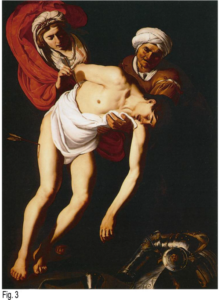 Baburen would return to Utrecht in 1620 where he, along with Gerrit van Honthorst and Hendrick Terbrugghen formed the Utrecht Caravaggisti. Although he died only four years later, his style continued to develop becoming less Italian and more distinctly Dutch. A comparison of M&G’s St. Sebastian Aided by St. Irene to an earlier version he completed while in Rome (Fig. 3) highlights these distinctions especially in the physical appearance of the characters. St. Sebastian was the patron saint of plague victims and a popular subject in religious art throughout the 17th century. The article by Armand P. Gelpi in the Resources section provides a detailed overview of his iconography and connection to the plague.
Baburen would return to Utrecht in 1620 where he, along with Gerrit van Honthorst and Hendrick Terbrugghen formed the Utrecht Caravaggisti. Although he died only four years later, his style continued to develop becoming less Italian and more distinctly Dutch. A comparison of M&G’s St. Sebastian Aided by St. Irene to an earlier version he completed while in Rome (Fig. 3) highlights these distinctions especially in the physical appearance of the characters. St. Sebastian was the patron saint of plague victims and a popular subject in religious art throughout the 17th century. The article by Armand P. Gelpi in the Resources section provides a detailed overview of his iconography and connection to the plague.
Dirck van Baburen died in February 1624; he was buried in the medieval parish church of Buurkerk. His teacher Paulus Moreelse would be laid to rest there 9 years later.
Donnalynn Hess, Director of Education
Resources:
Baroque Painting: Two Centuries of Baroque Masterpieces, Ed. Stefano Zuffi
“Religious Policies in the Seventeenth-Century Dutch Republic,” Jo Spanns
“Dirck van Baburen and the ‘Self-Taught’ Master, Angelo Caroselli,” Wayne Franits
“Saint Sebastian and the Black Death,” Armand P. Gelpi, MD
Saint Sebastian Attended by Saint Irene and Her Maid, Dirck van Baburen (attributed to)
Published 2024
Cassone
Walnut with parcel gilt
Tuscan, 16th century
While the Museum & Gallery is most widely known for its collection of religious Old Master paintings, the founder of the museum also developed “supplemental collections of period furniture, icons, decorative arts, textiles, and objects of art” (Drama & Beauty: Great European Paintings from the Bob Jones Collection). The original intent of these sub-collections was to provide a setting for the artwork that would allow modern viewers to understand and appreciate the religious and domestic contexts in which the paintings might first have been displayed.
By the 1970s notable authorities of furniture considered these once-ancillary collections to rival some of the world’s best. Joseph Aronson, who wrote a number of authoritative histories of furniture, “considered the Renaissance furniture collection the finest in America” and lent his expertise to write a catalog containing Furniture in the Bob Jones University Collection, which was published in connection with M&G’s 25th anniversary celebration in 1976.
Specifically, this Italian Renaissance walnut and parcel-gilt Cassone epitomizes the history, breadth, and educational value of M&G’s period furniture collection. Purchased for the collection in 1966, the Cassone came from French & Company, in New York City. Founded in 1907, French & Company was once considered one of the world’s largest dealers and had provided art, furnishings, and even interior design to some of the best-known families of America’s Gilded Age, including the Vanderbilts, Astors, Gettys, Rockefellers, Mellons, and duPonts (and subsequently in the collections of the major museums endowed by those families). The company thrived under its first two generations of leadership and was noted for its library of documentation, which provided purchasers with exhaustive histories (or provenance) of the items acquired. The company was then sold several times, and much of its remaining stock was auctioned in 1968. M&G is pleased to provide a home for a number of French & Company pieces.
The history of cassoni dates back to the fourteenth century. Originally functioning as wedding chests for new couples—and paraded through the streets in wedding procession—cassoni often contained the bride’s dowry and became cherished treasures in newly established homes. The decoration of cassoni grew in sophistication over the years and entire workshops were devoted to the artform. Frequently portraying Biblical, classical, or mythological subject matter, the front panels of these chests displayed any number of craftsmanship, from carving and gilding to built-up gesso decoration and painting. Even notable artists such as Sandro Botticelli, Paolo Uccello, and Donatello applied their skills to decorate cassoni for the wealthiest clientele.
M&G’s Cassone likely dates from 16th-century Tuscany and is constructed of carved walnut. Standing on diagonally-set lion paws, the chest’s special features include gilded gadrooning, the detailed and deeply-set carving on the front and side panels, as well as the ogee dome molding. The unique top paired with the end panels shifts the most intricately carved subject matter to the front of the chest and only the front two-thirds of each side (figure 1). This technique differs from the usual appearance of cassone, which are most often depicted at the foot of a couple’s bed in Renaissance art. It’s likely that this particular cassone was commissioned to solve a specific architectural challenge in its new home—possibly resting in the shallow recess of a wall or passageway. As such, it is not typical of the traditional traveling chest, but represents “a step in the evolution of the credenza form” (Aronson).
Also of interest, the remarkably dimensional, carved frieze (figure 2) has been variously explained as a battle scene or a depiction of Death riding an ox-drawn chariot through a sacrificial scene. The key clues in the frieze include bystanders observing the action from the safety of colonnades on the left and right. Most prominently on the front left is a woman holding a round vessel and a man who appears to be strangling a sheep held aloft in front of him. The front right draws the viewer’s focus to a king, surrounded by an entourage. The central figure in the scene is indeed a man on an ox-drawn chariot, riding through a plain, which is covered by furrows and ridges. Near him are 5 warriors with weapons drawn. More difficult to see in the distance above him on the plain (moving from left to right) are a ridged-back dragon, a tree, and a walled city on a hill.
Since cassoni often depict a felicitous message for newlyweds, using classical, biblical, or mythological imagery, deciphering the elements is a fascinating undertaking. In the case of this M&G cassone, newlyweds are reminded of the exploits and love contained in the story of Jason and Medea. While there are many Greek and Roman variations of the story, the key elements remain.
Jason’s father was the rightful king of Iolcus, but was overthrown by his half-brother, Pelias. Jason’s life was saved by his mother, who sent him away to be protected and educated by the centaur Chiron. When Jason returned and wished to re-take the throne, Pelias required that he undertake a quest to find and return the Golden Fleece from where it lay in Colchis. After a series of adventures Jason and the crew of his ship Argo (hence the collective name Argonauts) arrived in Colchis, where Jason requested the fleece from King Aietes. Aietes agreed to give Jason the Golden Fleece if he accomplished three feats of bravery intended to be deadly to Jason. Unknown to the king, his daughter, Medea, was charmed to fall in love with Jason and help him survive and succeed.
First, Aietes required that Jason plow a field with fire-breathing oxen, but Medea gave him an ointment to protect him from the flames. Jason next had to sow the field with dragon’s teeth. When he did so, the teeth turned into full-grown warriors (spartoi). They would have killed Jason, had he not been told how to defeat them. He threw a stone into their midst and the confused warriors, not knowing who had thrown the stone, attacked each other.
Finally, Jason had to retrieve the Golden Fleece from where it hung on an oak in the sacred grove of Ares. The grove was protected by an undying, unsleeping dragon. Here again Medea protected Jason by administering an herbal potion that made the dragon sleep. Finally, the hero and his love Medea flee from her father and return to take the Iolcus throne from Jason’s uncle. Unfortunately, their happiness was short-lived; but that part of the couple’s story is—understandably—not portrayed by the artisan of this very special Cassone.
Dr. Stephen B. Jones, M&G volunteer
Sources
Aronson, Joseph. Furniture in the Bob Jones University Collection. 1976.
Drama & Beauty: Great European Paintings from the Bob Jones Collection. Museum & Gallery, Inc. in association with D. Giles Limited, 2022.
Published 2024
Antiphonary
Italian, 16th century
Below the image, click play to listen.
This object is currently on display in Mack Library.
Enjoy this series of segments highlighting Picture Books of the Past: Reading Old Master Paintings, a loan exhibition of 60+ works from the M&G collection. The exhibit has traveled to The Museum of the Bible in Washington, D.C. and the Orlando Museum of Art in Florida.
In October’s Closer Look we explored Marietta Robusti’s Allegory of Wisdom. In this video we’ll look at a work by her father who trained her. (Following your video viewing click HERE to access the additional information provided on the exhibition’s text panels.)
Scenes from the Apocalypse
Oil on panel
Unknown French, mid-16th century
These M&G panels are painted sections from a winged altarpiece, positioned on, above, or behind the church’s altar. The wings or hinged doors would be opened for liturgical feasts and events. When the wings were closed, the side facing the audience was often painted in monochrome colors depicting various saints’ lives; as the wings were opened, the interior (including the other side of the doors) revealed more colorful pictures with a large feature painting in the center.
The Scenes from the Apocalypse by an unknown 16th-century French artist illustrates the medieval tradition of the Signs of the Apocalypse (drawn from Mark 13 and Revelation). These five separate panels were once joined in a single winged altarpiece with a total of fourteen or fifteen panels detailing the Signs and with the central interior panel possibly featuring the Last Judgment. Viewing these works from left to right,
- Panel 1 is the Third Sign: sea monsters that ravage the seas.
- Panel 2 is the reverse of Panel 1, being once united as a single panel.
- Panel 3 is the Second Sign: the seas disappearing into the earth.
- Panel 4 is the reverse of Panel 5, being once united as a single panel.
- Panel 5 is the Fourth Sign: the burning of the seas and rivers.
Two ideas are fundamental to understanding this altarpiece. First, these panels illustrate the Word of God. According to Pope Gregory the Great (lived c.540-604), “Illiterate men can contemplate in the lines of a picture what they cannot learn by means of the written word.” Seeing the horrors of the End Times should motivate the viewer to take action to avoid them. These panels become visual conviction.
The Bible portrays man’s sinfulness and presents the atoning work of Christ as the remedy. The panels’ subject matter confronts the viewer with the penalty for sin even before the Last Judgment arrives. Juxtaposing these panels directly with the altar argues that Christ’s sacrificial death on the cross, accepted by God the Father as payment for man’s sin and ratified by Christ’s resurrection from the dead, is man’s rescue from the Apocalypse. In view of these coming events, the physical placement of these panels prompts the viewer to appropriate for himself Christ’s sacrifice.
Secondly, the reverse of the panels—scenes from the lives of Old and New Testament figures—argues for the ability of humans to react properly to the revelation of God’s Word.
- Panel 2 references the conversion of Saul of Tarsus when confronted with the crucified Christ. The presence of the Holy Spirit as the dove and the holding of the slain Christ by God the Father clearly teaches the unity of the Trinity: Saul’s persecution of followers of Christ is persecution of the God that his pharisaical upbringing revered. The panel directly challenges the viewer to answer the Trinity in the same way Saul did: “What would you have me to do, Lord?”
- Panel 4 is the Woman Clothed with the Sun. She is labeled in the Revelation as a sign (12:1), but not included in the medieval list of signs. The artist portrays the Woman just as the Scripture does: “clothed with the sun, and the moon under her feet, and upon her head a crown of twelve stars.” Though many critics identify this Woman as the Virgin Mary, a continued reading of the biblical text—and a careful examination of the panel—shows that this Woman symbolizes the nation Israel whose annihilation the Dragon seeks in the Last Days. Note the dragon tail just visible at the bottom of the panel. The Jewish child is Christ who escapes the Dragon. But “the woman fled into the wilderness, where she hath a place prepared of God that they should feed her there a thousand two hundred and threescore days” (12:6). Mary is not present at the end of the world, but the nation that brought forth the Messiah is. This panel, too, points to Christ as the provision of salvation from destruction of the Last Days.
Like the Pricke of Conscience, a series of stained-glass windows also based on the Signs of the Last Days, M&G’s panels challenge the viewer to consider the Apocalypse from a personal point of view.
Dr. Karen Rowe Jones, M&G board member
Published 2023
